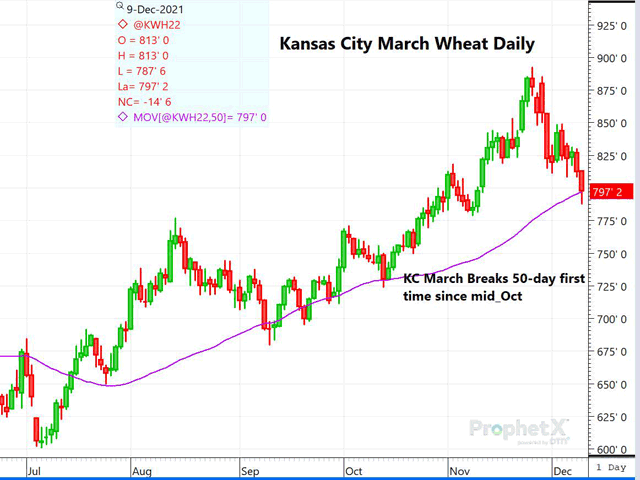USDA Reports Review
As Expected, USDA's December WASDE Held Few Major Surprises
USDA's December World Agricultural Supply and Demand Estimates (WASDE) report, not typically a big market-mover, had no domestic changes for the corn and soy balance sheets. It was the wheat market, both in the U.S. and globally, that had the most changes, with the net effect supporting the bearish trade prior to the report. Both U.S. and world wheat ending stocks rose by a bit more than expected.
CORN
Traders had expected a modest decline in U.S. ending corn stocks in the December WASDE report and indications were that corn for ethanol usage would be increased by possibly 25 million bushels (mb) or more. However, that was not the case and U.S. ending stocks were left unchanged at 1.493 billion bushels (bb).
There were zero changes to the corn balance sheet, which led traders to believe we will likely see ending stocks move lower in subsequent reports, as it appears that corn for ethanol usage could be understated by as much as 50 mb to 75 mb.
On the world corn front, there were only minor changes, resulting in a modest 1.1 million-metric-ton (mmt) rise in world corn ending stocks to 305.54 mmt (12.03 bb). Individually, both Ukraine and European Union corn production were increased by 2 mmt and 2.5 mmt, respectively, with exports raised in each country. Ukraine exports were increased by 1 mmt, with EU exports up 500,000 mt. The only other notable change was China's corn crop being reduced from 273 mmt to 272.55 mmt (10.7 bb) -- still record large.
The net effect of the report was that it was neutral to mildly bearish for corn. March corn finished report day up 4 1/2 cents.
P[L1] D[0x0] M[300x250] OOP[F] ADUNIT[] T[]
SOYBEANS
As in corn, only minor changes were expected to the U.S. soybean balance sheet and that proved to be correct. U.S. soybean ending stocks were left completely unchanged, although most in the trade had expected a modest increase of 13 mb, resulting from lower exports. Even with soybean export sales down a lofty 27% from a year ago, USDA chose to wait to make changes to the 2.050 bb export number. U.S. ending stocks remained at 340 mb. Minor product changes included soybean oil production increasing due to higher extraction rates. Soy oil for biodiesel was left unchanged at 11 billion pounds. Soybean and bean oil average prices were left unchanged at $12.20 and 65 cents, respectively. Soybean meal average price rose by $5 to $330 per ton.
Moving onto the global soy changes, world ending stocks on soybeans were lowered by 1.78 mmt to 102 mmt (3.75 bb). Notable changes that led to that reduction were a 500,000 mt decline in Paraguay production to 10 mmt (367 mb) and a 2.6 mmt drop in China soy production to 16.4 mmt (603 mb). Brazil and Argentine soy production were left untouched at 144 mmt (5.29 bb) and 49.5 mmt (1.82 bb), respectively. China's crush was reduced by 1 mmt to 97 mmt (3.56 bb). The fall in ending stocks was slightly bullish for beans, while the unchanged domestic stocks were neutral to friendly soy. January soybean futures were down 5 1/2 cents prior to report and closed up 3 1/2 cents for the day.
WHEAT
Strange as it may seem, it was wheat that turned out to be the headliner on this typically non-eventful USDA report. Traders had expected a decline in U.S. wheat exports and an ending stocks number at 591 mb. Instead, ending stocks instead rose to 598 mb, up 15 mb. U.S. wheat exports were lowered by 20 mb, with imports down another 5 mb. Within those numbers was an increase in hard red winter wheat ending stocks by 10 mb -- still the lowest in seven years -- and an increase in hard red spring wheat of 5 mb, with ending stocks at 132 mb, the lowest in 14 years, based on the poor pace of exports. The domestic numbers were just mildly bearish for the U.S. balance sheet.
In the world numbers, we had some more substantial changes, with ending stocks rising by a greater-than-expected 2.4 mmt to 278.18 mmt (10.2 bb). Australia's wheat production rose by 2.5 mmt to a record-large 34 mmt (1.25 bb); Canada's crop was increased by 700,000 mt to 21.7 mmt (797 mb); the EU's wheat crop was increased by 300,000 mt, and Russia's crop rose by 1 mmt to 75.5 mmt (2.77 bb). Argentina's crop, recently projected to be a record-large 22.1 mmt by the Rosario Exchange, was left untouched at 20 mmt (735 mb).
On the import side, China's imports of wheat fell by 500,000 mt to 9.5 mmt (349 mb) and imports by Iran were increased by 1.5 mmt to a record-large 7 mmt (257 mb), surpassing the old record of 6.8 mmt in 2008-09. World wheat supplies are projected to rise by 4.3 mmt while consumption is expected to be up 1.9 mmt.
The net effect of the December WASDE report for wheat was deemed bearish on both the domestic and world side, but prior to the report, Kansas City March wheat was already trading down 12 to 13 cents, finishing the day with a loss of 15 1/2 cents.
FINAL THOUGHTS
Following what has usually been considered a non-event, USDA's WASDE report did not disappoint on Thursday, Dec. 9. The markets were mostly neutral to bearish, especially for corn and wheat. Markets preempted the results of the report, with wheat continuing the recent sharp downward correction.
Now that the report is past us and we won't see final U.S. production numbers until January, traders will likely shift their focus back to South American weather and the brewing conflict at the Ukraine border. Any escalation in that conflict has the potential to turn the recently bearish wheat market back up.
Dana Mantini can be reached at dana.mantini@dtn.com
Follow Dana Mantini on Twitter @mantini_r
(c) Copyright 2021 DTN, LLC. All rights reserved.




